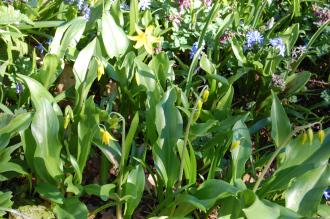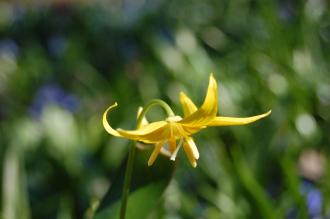
Erythronium tuolumnense (16/03/2014, Kew Gardens, London)
Position: Partial shade
Flowering period: Spring
Soil: Moist, well drained
Eventual Height: 35cm
Eventual Spread: 20cm
Hardiness: 5a, 5b, 6a, 6b, 7a, 7b, 8a, 8b, 9a
Family: Liliaceae
Erythronium tuolumnense is a deciduous herbaceous, bulbous perennial with a clump forming habit. Its glossy mid green leaves appear in pairs, are elliptic to ovate with entire margins, up to 35cm long and 6cm broad. Its yellow flowers are Lilly like, up to 4cm across and appear in groups of up to five on long, naked reddish stalks. Its roots emerge from an oval shaped bulb which is up to 10cm across.

Erythronium tuolumnense Flower (16/03/2014, Kew Gardens, London)
Erythronium tuolumnense, commonly known as the Tuolumne Fawn Lily or Tuolumne Dog’s Tooth Violet, is native to south west North America. In its native habitat it grows in moist deciduous woodland.
The etymological root of the binomial name Erythronium is derived from the Greek erythros meaning ‘red’, as to what the red refers to in this species we are unclear.Tuolumnense is derived from the Latin meaning ‘from Tuolumne County, California’, from where this plant originates.
The landscape architect may find Erythronium tuolumnense useful as a low growing herbaceous perennial, as part of a mixed herbaceous border.
Ecologically, Erythronium tuolumnense flowers are attractive to pollinating insects. Some mammals eat the bulbs of this plant.

Erythronium tuolumnense Leaf (16/03/2014, Kew Gardens, London)
The Royal Horticultural Society has given the species Erythronium tuolumnense their prestigious Award of Garden Merit in 1993.
Erythronium tuolumnense prefers moist, humus rich fertile, well-drained soils. It tolerates most pH of soil. It dislikes dry soils.
Erythronium tuolumnense requires little maintenance. Large clumps may be divided after flowering.

